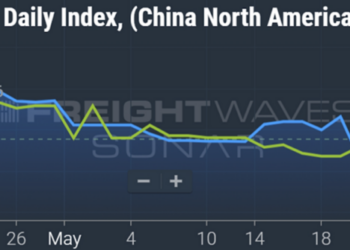Ocean spot rates have peaked, according to Maersk
Ocean spot rates from China to the U.S. West Coast are starting to look like a two-humped camel. (Chart: SONAR)
The reasons for an expected decline in spot rates from here include an easing in port congestion, expected seasonal declines in freight demand as the end of the year approaches and increases in ocean capacity, which is rising 2%-3% per quarter, according to Maersk. That said, ocean spot rates are still expected to remain at historically high levels since there is no evidence of a resolution of the Red Sea disruption in sight. The largest ocean carrier expects to avoid the Red Sea through at least the end of this year. The impact of the Red Sea attacks has, so far, more than offset the impact of capacity increases and assuaged carriers’ near-term concerns of an oversupplied market.
Meanwhile, ocean contract rates are expected to take another (perhaps last for a while) step up in the third quarter from second-quarter levels – contract rates generally follow the direction of spot rates, which rose sharply in the second quarter. Therefore, shippers that rely on the contract market should expect to pay more in Q3, but there is light at the end of the tunnel.
Intermodal is priced well below truckload, according to Hub Group
Domestic intermodal volume began surging in June, partly due to an increase in transloading. (Chart: SONAR)
Last week, domestic intermodal carrier Hub Group reported 8% year-over-year volume growth in its second quarter. That exceeds the 5% domestic intermodal volume growth shown in Q2 via the ORAILDOML.USA ticker and confirms that the company gained share in terms of total loaded intermodal containers. (J.B. Hunt’s intermodal loads declined 1% y/y in Q2.) However, in Q2, J.B. Hunt and Hub Group had widely different trends in volume by region with J.B. Hunt posting double-digit volume growth in transcontinental shipments outbound from LA while Hub Group’s volume was concentrated in the “local east” lanes, where volume grew 26% year over year.
SONAR data shows the intermodal contract savings rate versus truckload for long-haul, medium-haul and short-haul loads to be 17%, 6% and 4%, respectively. (Chart: SONAR)
The takeaway for shippers is that carriers, such as Hub Group, are willing to work with them on rates to encourage the use of domestic intermodal in Eastern lanes, as opposed to truckload. The carrier said the spread in contract rates between intermodal and truckload in local east lanes is currently about 20% while it is about 30% in longer-haul transcontinental lanes. That 20% spread in local east lanes is likely larger than a lot of shippers realize and represents a strong value proposition considering the currently strong rail service. It should be noted that the carrier was comparing intermodal contract rates to truckload contract rates. Currently, truckload spot rates remain depressed in a lot of lanes, so nimble shippers, likely those moving relatively little volume, may still be better off using the highway in modally competitive lanes.
Rail State data shows impact of Jasper Wildfire
(Image: FWTV)
On Monday’s The Stockout show, I interviewed John Schmitter, CCO and co-founder of Rail State, a company that collects and provides railroad service data to shippers and government agencies.
Rail State began by placing sensors adjacent to railroad waysides in Canada, collecting data in real time on railroad speed and service levels. The data is of particular value when there are disruptive events such as extreme weather, work stoppages, mainline outages or simply general congestion. Rail State’s data showed that in late July, the volume of trains on certain subdivisions in Alberta fell from 30 or more per day to zero as a result of wildfires in the province. Other sources of current disruption are related to labor. CN’s international intermodal volume is being negatively impacted by vessel diversions away from Canadian ports – Prince Rupert in particular – as some shippers and ocean carriers hedge against labor stoppages by rail and/or port workers.
In addition to volume figures, Rail State provides shippers with estimates of transit times, which is particularly helpful when shippers have the option of using another railway or another mode of transportation. Rail State is also building out its data collection in the U.S., starting with the Southwest. That region has been impacted by extreme heat, which can cause delays associated with additional track maintenance.
Watch Monday’s show here or see the full The Stockout playlist here.
The post Ocean spot rates have likely peaked appeared first on FreightWaves.














